Abstract
The article is tasked with studying the modern possibilities and effectiveness of the application of virtual and augmented reality technologies in the field of managing human recourses (HRs) and basic operational corporate business processes. Using examples of successful use of AR (augmented reality)/VR (virtual reality) in the labor market by the largest companies in the USA, China, and Europe, the most relevant areas and forms of using these technologies in the work of HR specialists were considered. The study examined issues related to improving the performance of the main modern vectors of corporate development in the field of operational technological improvements, and, as the main result, a model of the company (organization) development was proposed based on improved management of business and HR processes using VR and AR tools. The developed model demonstrates the advantages of using it, and presents the reasons for the economic expediency of using these technologies at all stages of personnel management, including recruiting, staff selection, demonstration of the employer’s brand, testing candidates’ skills, improving internal communications, creating a positive corporate culture for employees, imitating the workflow, VR and AR-simulations as a tool for passing the input testing for recruitment, selection and management of remote employees, training, assessment, and adaptation of staff. The possibilities of using VR/AR as tools for operational improvements (lean management), for example, for organizing virtual business meetings and meetings, creating virtual presentations, online controlling in the manufacturing sector, automating operational processes, and using VR technologies, are also separately disclosed in the management of logistics, distribution, marketing, and advertising. The results of the analysis of theoretical and statistical sources of information showed the promise of using the possibilities of virtual reality in corporate management, which shifts the emphasis from the traditional understanding and perception of these technologies exclusively in the entertainment field. The obtained developments within the framework of the conducted research are universal in nature and can be applicable both in the study of modern methods of personnel management and in corporate lean management of modern business companies at various levels.
1. Introduction
Currently, virtual reality technologies are of increased interest not only in the entertainment industry, but also in many other areas of society, such as, for example, industry, medicine, and education. Today, the world’s leading companies—Ford, Boeing, Mercedes, Walmart, Jaguar, Huawei, and Haier—are introducing new technologies into various business processes: One part is experimenting with innovations, the other uses VR technologies to increase the company’s awareness on the market, and improve existing computer technologies design, to test products. There are many scenarios of industrial application of AR (augmented reality)/VR (virtual reality) solutions, from visualization of prototype technology components to the complex development of interactive workshops for personnel at hazardous industries [1,2,3].
One of the newest, but already successful, tools in many business segments (including in the HR sphere), today are AR and VR. Virtual reality offers human recourse (HR) employees a new way to provide an interesting experience for candidates and employees through basic HR processes—hiring, adapting, training, organizing work [4,5]. Interactivity, which is at the heart of AR/VR, allows not only assessing the competences and skills of a candidate or company employee, but also identifying his strengths and weaknesses. It allows determining the behavior of the individual in a critical situation and his/her skills of taking challenges at work and finding a common language with customers or business partners. AR/VR is often used to present the best sides of the company to potential employees, as well as to attract market specialists. Virtual reality is a fairly new technology and; therefore, it is of interest to the audience and helps companies improve their competitiveness, especially if the company is actively working with the younger generation [6,7].
The authors of this paper define how to improve the efficiency of HR and the main operational business processes of international and national corporations seeking leadership in the market with the help of AR/VR tools. As shown by the forecasts of the world’s leading analytical and financial agencies, Asian digital giants that produce AR/VR products, in particular, Chinese companies Huawei, HTC, ICL, and others, will push the American and other Asian competitors in the long term. It is necessary to understand what the demand for the products of these companies dictates, why the scales are leaning in their direction, and what they can offer in order to remove weaknesses, optimize the recruitment processes and the development of employees of companies seeking leadership, improve and optimize core operating business processes that will reduce the number of costs and increase profits, etc. All this is the essence of modern corporate lean management, one of the most priority tasks of which today is the digitalization of the global business space.
The general aim of the study is to explore issues related to the use of AR/VR technologies in the management of sustainable development and digitalization of HR and other operational corporate business processes in China and the world. Models of using VR/AR technologies in the entertainment sector (video games, 3D visualization learning technologies for children, etc.) served as prototype models for developing an approach to use these technologies in corporate management.
2. Literature Review
Recently, China has gained an active position in the AR/VR industry. AR/VR technologies are beginning to be used in the work of HR specialists in divisions of large Chinese and representative offices of foreign corporations. Despite the huge number of residents, there is an acute shortage of qualified staff in the country. According to the McKinsey Global Institute study, only 10% of graduates from Chinese universities—about 4 million people—have the skills necessary to work in foreign companies operating in China [2,5]. As a result, due to the lack of qualified personnel and high turnover, it is difficult for companies to attract, train, and retain the specialists they need to develop and increase competitiveness. For example, between such giants as Huawei and Haier for several years now there has been a struggle for talented employees. HR specialists are not always able to cope with the difficulties of the Chinese labor market; therefore, companies strive to improve the efficiency of personnel processes, programs, and mechanisms. The level of efficiency of HR professionals becomes a critical factor in the success of a business. It is about the ability to make complex strategic decisions, and not just to perform tasks at the tactical level. In turn, the use of technologies, in particular, technologies of virtual and augmented reality, of course, will allow for the improvement of the efficiency of HR processes [4,8]. In addition, it should be noted that, at present, the use of AR/VR simultaneously in HR and core business processes (production/provision of services, logistics, marketing, distribution, design, modeling, IT, cybersecurity, etc.), which should be directed on operational improvements, by achieving a synergistic effect, will take the company to a new level and open the way to leadership in the industry on a regional and global scale [3,9,10]. AR/VR is also an excellent tool for testimonials—the ability to give a person a complete picture of his new workplace and responsibilities and thus adjust his expectations, and, consequently, increase the success of adaptation [11,12].
Adaptation for many HRs in China is a development zone. Attention should be paid to this, as it is fraught with not only staff turnover, but also damage to the company’s image, as well as the possibility of errors due to incorrect actions of a new employee. A problem solution is virtual briefings that save the HR specialist’s time and acquaint the new person in the company with the specifics of work, office activity, general rules, and trends. This approach allows not only to inform in theory, but to bring and visualize all the information necessary for a new employee, to show the stages of work of each division of the company [13,14]. It is also worth noting the advantages of introducing VR learning technologies, as evidenced by the experience of their implementation by Chinese companies. In addition to the above, this is a lack of serious effort on the part of the HR trainer, and facilitating the process of training new employees working remotely. VR simulators teach new employees to work with expensive or dangerous equipment without the risk of breakage. The technology allows companies to simulate real-world scenarios of various situations. An AR/VR developer can create a copy of a workplace where an employee can work through a situation without going to remote or dangerous objects. AR/VR allows not only to train employees and consolidate their knowledge, but also to give an accurate assessment and to point out all possible errors in carrying out the task [11,13,15].
However, taking into account all the advantages, it should be noted that AR/VR technologies for business can be an effective tool only if their implementation is justified by the real needs of the company. In addition, along with taking into account the specifics of companies, it is necessary to systematize their experience in using AR/VR to tackle personnel strategies, develop basic provisions for applying virtual capabilities and explore the issue of training HR employees themselves who are ready to use new technologies in their work [3,14,16].
VR/AR technologies and tools are used in training processes, during 3D modeling in technological processes, delivery processes, organizational meetings, and in many other processes. The usage of VR/AR technologies is described in many scientific papers nowadays, confirming the extremely high relevance of this topic. The high efficiency of VR/AR modeling in the technological processes is also noted in most works on this topic. Hence, for example, there is an increase in the quality and speed of the collection and processing of anthropometric data for control at modern nuclear power plants. These technologies are actively used in many areas related to information security, including cybersecurity [17].
Some scientists focus on the need to apply VR/AR technologies to science, in addition to the entertainment and corporate management spheres of application. It is proved that 3D models should be actively promoted as scientific resources and assets both as digital cultural artifacts and as tools to help the public explore the vital but often overlooked relationships between the created heritage and the natural world [18]. As can be seen, the integrated use of VR/AR technologies and tools in HR management and operational and technological business processes, both in the medium and strategic perspective, is the path to sustainable development.
In general, the research questions addressed in this study are:
- -
- Analyze the state of the world and Chinese AR/VR industry and market conditions, and determine the prospects for the development of the industry for the next few years;
- -
- Assess whether the use of AR/VR technologies is not only effective in the entertainment sector (video games, TV content), but also in the corporate sector for managing HR and operational business processes;
- -
- Analyze the forecasts of the development of AR/VR in the world, the Asian region and China, evaluate and identify possible changes in the direction of investment in China and Asia;
- -
- Develop a model for the development of a company (organization) based on improving the management of business and HR processes using VR and AR tools.
3. Methods
3.1. Research Design
The study explores the state of the AR/VR market in China, the Asian region, and the world, the potential for the development of this industry in the region, the justification of the need, and the availability of supporting factors in related industries (IT, Internet, mobile devices, and technologies). Its objective is to determine the potential effectiveness of VR/AR tools and technologies in managing HR and other operational business processes, and their prospects.
In the process of working on the article in the framework of the research, the methods and approaches of the general scientific group were used—methods of theoretical generalization (for analyzing scientific literature, analytical reviews, reports of international research organizations regarding VR/AR technologies), structuring, analyzing, and synthesizing (in the study of the state and prospects for the development of international and national Chinese as part of the IT- and focused-VR/AR market of the Asian region), a comparative approach (when comparing the experience of Chinese IT-corporations and those engaged in the development of VR/AR products and their competitors from other regions of the world) and statistical-economic methods of analyzing statistical data, forecasting (when forecasting market development, changes in world market conditions), regression-correlation analysis (performed in the Excel environment), and financial analysis (when analyzing the financial performance of Asian and other global IT corporations). Additionally, a modeling method was used in the work when developing and constructing the model of development of a company (organization) based on improved management of business and HR processes using VR and AR tools.
3.2. Limitations of the Study
This research is limited to studying the possibilities of using AR/VR tools and technologies in the current needs and environment of corporate management in China and around the world. This research does not include the history of their occurrence or the analysis of the beginning of their application in the entertainment sector. In this research, there is no study of their gradual transfer to the corporate environment—for organizing business meetings in virtual rooms, training students and employees using 3D simulations of production situations, etc. The study also does not concern issues related to the possibility of using these technologies in public administration or other types of activities.
4. Data Analysis
Most sources of information, such as China’s VR Industry Report (2017, 2018), Goldman Sachs Global Investment Research, IDC, Augmented and Virtual Reality Survey report (Perkins Coie, 2019), Big4 companies, etc., indicate active development of smart technologies. At this point in time, the attention of the world’s leading corporations in technology, such as scientists, inventors, and investors, is beginning to focus on the VR/AR industry. Many are beginning to understand the strategic importance of this tool and believe that very soon it will become an essential tool to help manage corporate HR and business processes in many companies around the world [2]. Analysts in the field of IT, globalization, and sustainable development believe that the future has already come and this is virtual reality (VR). According to the company SuperData, the global VR market will reach $40 billion by 2020. VR is currently reorienting from the traditional field of use, entertainment, but strategically-minded companies are already starting to embed virtual reality into business processes.
One of the key applications of AR/VR technology is HR, in particular, personnel training using 3D simulations, conducting trainings, staff meetings, video interviews with candidates, etc. HR is becoming increasingly more technologically advanced—this was important and convenient before just to save time and finances.
Figure 1 shows the distribution of the boundaries of the use of VR and AR technologies across different business sectors, and their growth by 2025. Thus, by 2025, the entertainment sector (33%) will still retain a dominant role in the overall structure of the AR/VR market. Further, in second place is Healthcare, and in third place is Engineering, even ahead of the entertainment sphere—live events and video entertainment. As you can see, AR/VR technologies and tools are already used now and will be further applicable in the military industry, education, real estate, and retail [1,10].
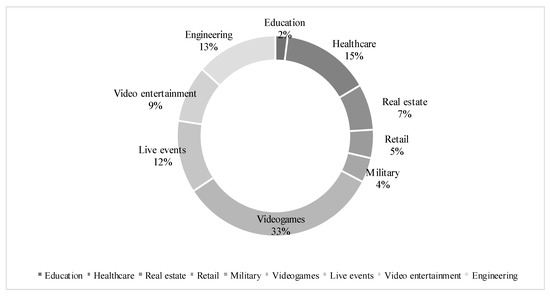
Figure 1.
The diverse of AR (augmented reality)/VR (virtual reality) Applications. Predicted market size of VR/AR software for different use cases in 2025 (base case scenario). Source: Goldman Sachs Global Investment Research [1].
When analyzing the place of VR/AR technologies in the overall structure of smart technologies, it is easy to see the correlation between them and the growth of mobile application business. As you can see in Figure 2 and Figure 3, VR/AR has the greatest weight in the area of mobile applications, which are already, in 2017–2018, pushed out to second place by technologies on PCs and consoles and smart glasses; the first VR/AR to appear on the market is already in the third position. In 2020–2021, according to forecasts, this trend will continue.
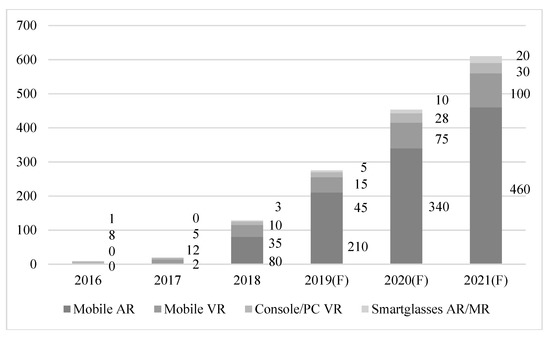
Figure 2.
Digi-Capital VR/AR installed base. Source: [2,7]. Notes: The numbers in the figure represent Smartglasses AR/MR, Console/PC VR, Mobile VR and Mobile AR from top to bottom.
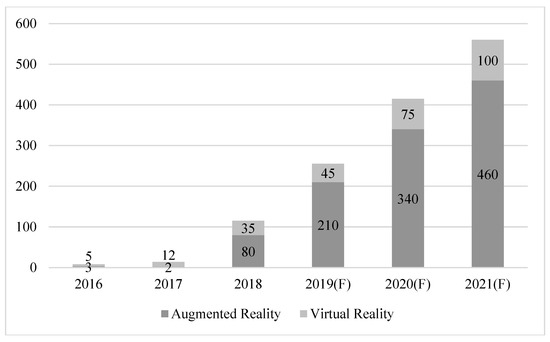
Figure 3.
Digi-Capital VR/AR installed base. Source: [2].
Comparing the prevalence and growth dynamics of the tools of full virtual reality visualization (VR) and augmented (AR) in the general structure of VR/AR (figure below), it is easy to see that the AR tools dominate. This situation is explained by the fact that, at this point in time in business, most often technologies of this type are used during negotiations, meetings, video interviews with candidates, training videos, etc.; as for managing operational business processes, production modeling is still more applicable for VR tools. However, the future lies ahead.
At the moment, the leaders in the industry and international VR markets, according to the international statistical agency Statista and PwC research globally and in the Asian region, are the United States, China, and Japan [19,20].
It should be noted that, according to research, PwC and Statista global statistical resource, starting in 2016, the world leadership in the VR/AR industry belongs to three countries—the USA, Japan, and China (see Figure 4); as you can see, from 2016 to 2018. Further, up to 2021 (forecast data) for this industry for all leading countries there will be a growth trend. So far, in this industry, the United States is in the lead, China is in second place, and Japan is third. This is partly due to the fact that a significant amount of entertainment video content is produced in the United States. However, when the scope of VR/AR changes from entertainment to corporate, there may be changes in global leadership in the industry.
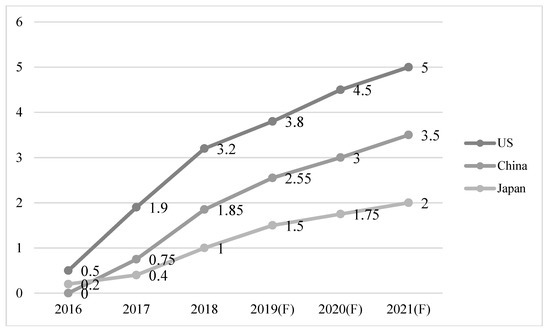
Figure 4.
Market leaders in VR. Revenue forecasts for the three largest virtual markets, bn $. Source: Statista, PwC [19,20].
At this point in time, the attention of the world’s leading corporations in technology, such as scientists, inventors, and investors, is beginning to focus on the VR/AR industry. Many are beginning to understand the strategic importance of this tool and believe that very soon it will become an essential tool to help manage corporate HR and business processes in many companies around the world [2].
Analysts in the field of IT, globalization, and sustainable development believe that the future has already come and this is virtual reality (VR). According to the company SuperData, the global VR market will reach $40 billion by 2020. VR is currently reorienting from the traditional field of use—entertainment—but strategically-minded companies are already starting to embed virtual reality into business processes.
If you analyze the world leadership in AR/VR in the context of companies engaged in the development and trade of these technologies, the situation is as follows. On the international market, according to the data of the research of the International Data Corporation (hereinafter referred to as IDC), Samsung (South Korea), Sony (Japan), Facebook (USA), HTC (China), and TCL (China) have the highest turnover (Figure 5). As you can see, this is confirmed by the Statista and PwC data presented above. Comparing the results of the second and first quarters of 2018, you can already see an increase of 12% to 15% [4].
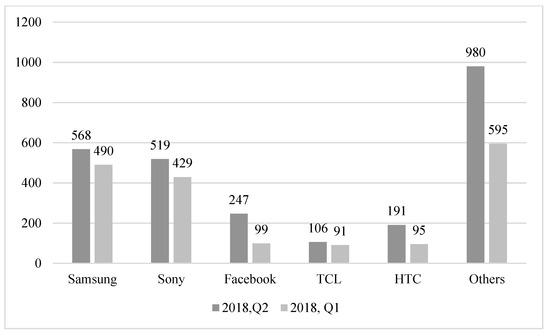
Figure 5.
Worldwide AR/VR leaders, Q1–2, 2018. Source: IDC [10].
Many analysts point out the interconnection between the growth and development of VR/AR technologies and the growth of the mobile technology industry. In reference to the data depicted in Figure 5, they prove this conclusion is rather true. The financial statements and press releases of companies with the largest shares of the international mobile market—Samsung, Apple, Huawei, Xiaomi, and Oppo—indicate that, since March 2018, Chinese business represented by Huawei is beginning to overtake Apple in the volume of mobile production and smart technologies (Figure 6). This may indicate a shift in world emphasis from the United States to China in the not too distant future.

Figure 6.
Market share for smartphone production in millions of units, 2017–2018. Source: IDC [10].
The volume of Internet consumption by the population is growing in China (Figure 7). Starting from 2012, already in 2018 this indicator grew almost 25 times using forecasting tools; this trend is characterized by a polynomial dependence, and the growth trend will continue for the next few years.

Figure 7.
China cellular internet data usage and growth. Source: [21,22].
Starting from 2012, the volume of Chinese exports of IT products and technologies is also growing (Figure 8).
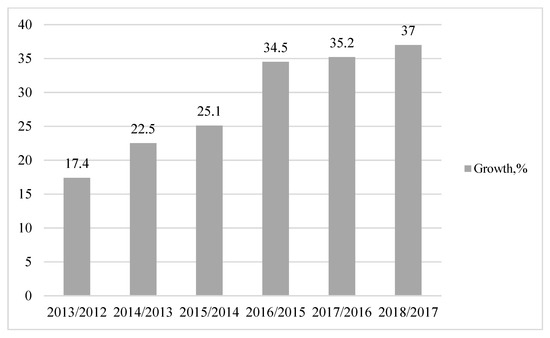
Figure 8.
China’s high-tech exports’ growth, 2012–2018. Source: The author’s calculations, based on the data of Statistics on Science and Technology, the Chinese Ministry of Science and Technology [22].
Comparing the volume of VR exports in China with the rest of the world supplying VR, you can see (Figure 9) that China occupies a significant share (about 30%) in the overall/general structure of global VR exports, and, also, over the past few years there is a trend growth.
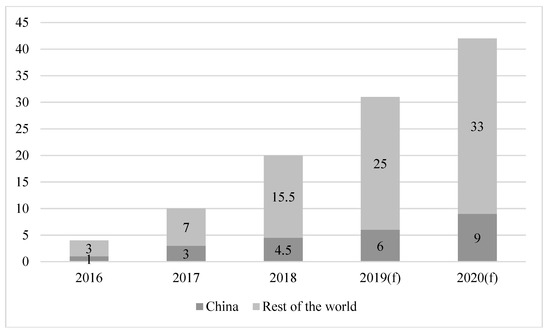
Figure 9.
Virtual reality headset shipments, forecast, millions. (VR users in China and in the rest of the world). Source: iResearch, Goldman Sachs [1,2].
Considering the situation in the field of investment in AR/VR technology, it is clear that Chinese venture capitalists focused on the long-term, which is explained by the relatively fast rate of payback and high profit margins. Thus, in the last 10 months of 2018, the SenseTime Group attracted more than US $2 billion, and Megvii-more than US $1 billion. Small investments (by Chinese standards) in hundreds of millions in 2016–2018 were sent to such companies as Beijing Moviebook Technology, Kujiale, and others [21].
Table 1 presents the results of a survey of experts in the field of AR/VR regarding their views on the size and changes in the share of Western investments in the Asian industry of AR/VR in 2019 and 2021.

Table 1.
Sectors that will see the most augmented/virtual reality investment according to US AR/VR professionals, September 2019 and September 2021, percentage of respondents.
According to experts, investments in such sectors as education (personnel training), health care, real estate, marketing, manufacturing, and the automotive industry will increase, and, conversely, in the field of entertainment content—video games, Movies, and TV—will decrease [6,8,23,24,25].
This suggests the prospect of a shift in the direction of international investment from the western (US) to the Asian region, in particular, China.
In order to justify the relevance of the study, specific examples of world experience in the use of VR/AR technologies in the management of HR and business processes. Thus, using the AR app and some iPads, at the job fair in 2014, Hershy’s (USA) representatives presented a specially designed AR wall that skillfully conveyed company values, team-oriented and service-oriented, so that employers could experience the whole process of recruiting.
Jaguar is one such company that has developed a mixed reality application to attract talent and testing skills. As part of an initiative to hire electronics and software engineers, the car manufacturer teamed up with Gorillaz to create an AR game that tested employees using games with code violations. It was beneficial for recruiting because people who played the game were more likely to find jobs using traditional communication channels. As a bonus, Jaguar was also able to quickly track down people who performed well in the game [1]. General Mills has deployed this strategy with great success. Using the Oculus Rift headset, General Mills has developed a virtual tour of its headquarters, which gives beginners an idea of what it is like working in a company. As part of the application in this game, AR proved to be a useful tool in improving the candidate’s experience.
In 2016, the British financial agency Lloyds Banking Group announced the beginning of the use of VR technology for interviews. Agency recruiters are already watching how the candidate solves problems in virtual reality. In this case, applicants will be able to move freely in the virtual world and move objects. Siemens has developed a Facebook game called Plantville. In the game, the user controls the virtual factory. They must hire and develop personnel, manage resources, and adapt to external conditions that may affect work [26].
The application can not only attract more people to the production, but also teach employees some factory management skills. Thanks to an integrated AR tool that better imitates the real-world experience, candidates will be more involved in the learning process.
Sberbank of Russia also spoke about the use of VR for personnel, planning global technological innovations in 2020–2021. Some US schools use the TeachLive program, a classroom simulator for teachers. Virtual students ask the teacher tricky questions, misbehave, and create difficult situations, and the teacher in the VR helmet learns to respond correctly. Such a simulator helps young teachers to get used to a difficult school environment even before coming to work, and experienced teachers to adapt new teaching methods [6,27].
5. Results
As shown by the results of analysis of theoretical and information sources (Section 5), in recent years there has been an active development and growth of investments in VR and AR business. The number of VR users is growing both in China and around the world (Figure 9), consumption indicators of Internet and smart technologies (Figure 7), which indicates the transformation of the role of VR and AR from gaming technologies, used mainly for entertainment purposes in modern and effective tool applicable in the business environment-both for managing employee training, recruiting purposes (testing candidates’ skills, conducting video interviews), marketing, forming an employer brand, and for main operational business processes, for example, measurement, 3D visualization, and modeling allow you to improve technologies, identify weak points, reduce risks, and reduce the time for testing, rather than using real objects and processes.
This suggests that companies are now starting to see VR and AR as an asset that can be used in recruitment functions and rely on digital creative agencies to provide training for their employees using these tools. Analyzing the modern possibilities of using tools of augmented and virtual reality, it is clear that virtual reality can become an indispensable assistant in both HR management and main operational business processes. Below are the main areas and segments in which these tools can be applied.
5.1. Recruitment—Staff Selection
If a company wants to attract the best specialists, they should be able to talk about the advantages of working there. In the past, this could be done through a brochure or video at a job fair. Now with VR/AR, companies can present their employer brand to employees with high and impressive experience. When used at job fairs, the booth can be configured to interact with applications in various ways, by providing step-by-step tutorials to interested parties, get potential employees acquainted with the benefits of working at a company, and also make them feel the workplace culture, as brochures can sometimes not be enough. VR/AR is also well suited for finding employees with the necessary skill set for the company. For example, a company may create an AR game that requires the use of a series of skills necessary for success at work. Candidates can download the game and get a chance to demonstrate their value to the company. This tool, if properly applied, can be very effective in attracting candidates, and also allow the company to assess the talent of each client.
Developing a positive workplace culture is an important part of recruiting. Modern businesses like to demonstrate a relaxed atmosphere where employees can freely search for new ideas and work on their own terms. Explaining this experience can be one of the ways to express the value of a corporate culture, which is currently an essential part of the development strategies and leadership of any corporation. Using technologies such as VR/AR, an employer can show an interactive course for an employee and, in general, everything that a given workplace can offer. Companies can develop simulations, a kind of game for attracting and hiring talent. Although the game may not cover the whole range of areas of work that the company does, it can be a great way to attract people to the company. This can also be useful in teaching them some of the skills they may need to succeed [7].
Today, many companies are collaborating with remote employees. There are two common scenarios for the selection of employees of this type: To invite all candidates to the main office, or (the more popular option) to use the online interview. But talking on Skype will not help to form an objective and complete impression of the candidate. With the help of VR, recruiters will be able to fully assess the applicants’ reaction to questions, their facial expressions, gestures, and other means of non-verbal communication. One of the most important personnel assessment procedures is a business game that simulates real situations in the workplace. The assessment is often used in the selection of applicants, and the games may be replaced with situational questions or case interviews. Unfortunately, not everyone possesses abstract thinking and is ready to show all professional competencies in such an interview. There is another danger: Employees can perfectly show themselves, but get confused when meeting with real customers. VR makes the assessment conditions closer to real ones by almost 100%. In this case, the applicant is evaluated not by a person, but by a system.
5.2. Staff Adaptation and Training
It is no secret that those employees who interact with each other move much more productively towards a common goal. VR technology comes to the rescue again. In one day, a new employee can visit the office of the CEO, go to production, greet in person with each colleague, and follow all the functional processes in the company. In addition, VR can perfectly contribute to team building. Modern practice shows that VR creates an imitation of the working environment and works more efficiently than theoretical training sessions and lectures. As they say, a picture is worth a thousand words. In addition, VR can significantly reduce the economic and time costs of staff training. Many companies, especially regional ones, send employees to trainings in other cities and they pay for travel and hotel accommodation. This need disappears with the advent of virtual reality.
5.3. Organization of Online Working Environments
VR tools allow you to hold meetings with employees or business partners located anywhere in the world. While in a virtual conference room, you can have a meeting with colleagues face to face, even shaking hands with VR gloves. In addition, when using this tool there is the possibility of organizing meetings with remote employees.
With the help of VR, it is possible to demonstrate to colleagues the presentations and visualize projects, which will make it possible to more efficiently structure and present the proposed project, to demonstrate in detail all its advantages, to attract the attention of the presentation audience in more detail, etc. [27]. 3D visualization will create a continuous system of control over the flow of the main operational processes in production, or when providing services, to see and visualize weaknesses, operations that can and should be automated, etc. In the end, this will positively affect the reduction of company expenses.
5.4. VR Technology in the Management of Logistics, Distribution, Marketing, and Advertising
VR/AR tools allow you to create 3D promo videos that allow you to advertise your products or services, attract new customers and enter new markets. In addition, VR/AR technologies allow you to create new and integrate existing distribution channels, manage supply chains, detail routes, etc. Summarizing the above-mentioned areas of application of VR/AR technologies and tools, as well as the results obtained in the previous sections, as a result of the study, a model of company (organization) development was developed based on improved management of business and HR processes using VR and AR tools (see Figure 10). Unlike the existing ones, this model is based on the synergistic effect of using VR/AR technologies and tools simultaneously in both HR processes (recruitment, development, training, personnel evaluation) and in the main operational processes—production, logistics, marketing, and others. It is known that despite the relatively high costs of VR, they are applicable in almost all business processes that can be directed to operational improvements, and will attract and develop employees that will lead the company to lead positions in the market. Considering the active development of information, mobile, and other smart technologies and the growth of investments in the IT sphere, both in China and around the world, it is clear that VR/AR will reduce costs, improve the performance indicators of the company as a whole, and take a strong position in domestic and international markets.
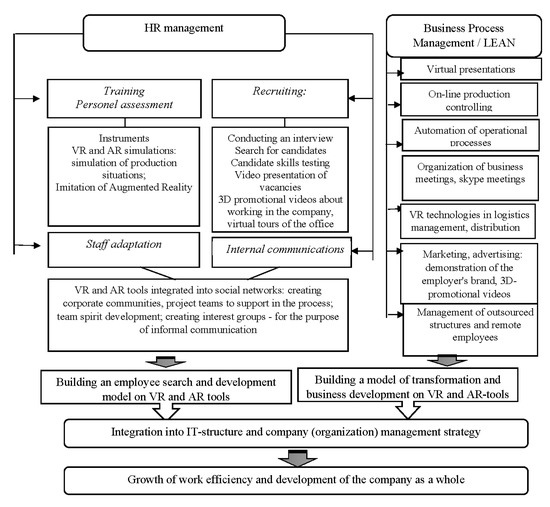
Figure 10.
Model of development of a company (organization) based on improved management of business and HR processes using VR and AR tools.
6. Discussion
The essence of the scientific discussion, which is caused by the development and distribution of AR/VR technologies and tools in the world, as already shown by the results of theoretical analysis (Section Introduction), is closely linked to the need to shift attention from the entertainment sphere of the use of AR/VR to corporate governance. Below is a brief analysis of the directions and views of scientists regarding the nature, importance and prospects of development of these technologies, as well as the effects that can be obtained with their correct and rational use in the field of corporate management. Of course, virtual reality technology is still far from ideal. Many companies are frightened by the cost of implementing VR in all HR processes. In addition, to “shake” large slow-moving corporations to innovate, it takes a lot of time and effort, and the quality of virtual reality itself often requires more improvements. However, 20 years ago it seemed impossible to conduct interviews “at a distance” and hire half the staff of remote employees. Technologies are capable of surprising, and maybe in five years our reasoning about the benefits of VR in HR will turn out to be naive and obvious. Most researchers analyzing aspects of the use of virtual reality technology in the work of HR specialists come to the conclusion that, despite the existing successful examples and results of using VR in the labor market, this trend, along with its relevance, still has enough questions and problems, especially in their modern business processes [11,28].
Experts analyzing the relationship between the development of VR technologies and globalization processes, both in the Asian region and in the world as a whole, agree that currently the main trend is the driver of world progress and, above all, the development of IT, information, and 3D technologies are just globalization and integration processes of the world economy. The dynamically developing environment of trans-nationalization of international companies, which should be managed more and more globally, requires new strategic approaches to resource management [8,25,29]. The transformation of the work of HR professionals is becoming one of the key success factors for almost any large business. It concerns the ability to make comprehensive strategic decisions and the need to create a sustainable base of labor, the size of which can be changed as needed. This base, in turn, requires the introduction of processes and practices that use the latest achievements of the IT sphere. The efficiency of personnel management must grow with the help of new high-tech tools, including AR/VR [16,27].
Recently, despite the increased interest in virtual reality technologies, they have already been used to solve various practical problems and real business cases for more than a dozen years. It should be noted that it has been 30 years since the day that the VR display was developed at NASA. But, given the fact that earlier this technology was available only to military and major companies and scientific institutes, but now the cost of wearable devices allows them to be used in many industries, and thanks to the computer gaming industry people have cheap and powerful graphics cards that provide the high frame rate required for convincing VR use [8,10]. Existing VR devices—virtual reality helmets, projection systems such as virtual reality rooms, CADWALL with built-in tracking systems—allow the user to perceive 3D graphics as realistically as possible, which together with specialized software provides the maximum realism of sensations from working with a virtual prototype of a future object [17,30].
You should also not forget about the existence of some factors that hinder the introduction and wide distribution of virtual reality technologies in the business sector. The main obstacle is still the high cost of solutions and technologies, while there is no clear correlation with economic efficiency. In addition to high costs, there are also technical limitations and high complexity of introducing VR technologies [31]. This indicates the lack of the necessary number of qualified specialists in the market who are able to implement and maintain professional VR systems [32]. In addressing these issues, China’s position is revealing, where VR came into use in the education system, where exchange platforms are created to integrate entire industries and create VR cooperation platforms between them [33]. Companies are invited to share information with each other in order to accelerate the development of virtual reality. To effectively use AR/VR, one should also take into account the specifics, cultural traditions, and demographic characteristics of the country where recruitment takes place. In addition, it is necessary to analyze the psychological and social aspects of VR exposure in humans [34]. Of course, AR/VR technologies, in particular in HR and lean management, belong to the future, but today technologies successfully complement the work of these specialists, transform it, increase efficiency, etc. [1,11,18,35,36,37].
7. Conclusions
Summarizing the results of the research, the conclusion is that, despite the traditional understanding of their use in the entertainment sector (video games), AR/VR technologies and tools are quite effective and useful in managing corporate business processes, primarily HR (for the purposes of recruiting, training, development, personnel evaluation) and basic operational processes (3D-visualization, modeling of production processes, large-scale projects, elimination of “weak” places, automation, modeling of IT risks, cyber security, etc.). The development of this industry and the shift of the focus from the entertainment sector to the corporate sector are evidenced by research data of international companies and statistical organizations, including PwC, IDC, Statista, etc. The growth in consumption of Internet technologies, the export of IT and mobile products, and the growth of mobile technology markets are indicative of the prospects for the development of AR/VR in China, Asia, and around the world. It is also important to note the partial outflow of investments from the western region of the world (USA) to the Asian region, and, in particular, to China, as well as fluctuations in demand for VR, and the periodic preponderance of the supply of mobile products and technologies of Chinese companies such as Huawei and Xiomi over Apple. This speaks, at least, of the prospects of the Chinese VR/AR industry, and, as a maximum, about global leadership in the not too distant future. The main result of the study is to develop a model of the company (organization) development based on improved management of business and HR processes using VR and AR tools. The model is based on the synergistic effect of the use of VR/AR simultaneously in HR processes (recruitment, development, training, staff evaluation) and in the main operational processes—production logistics, sales, etc.—which ultimately will reduce the costs of production, develop employees, and increase the cost of the intellectual of the organization (which, for example, can be expressed in the rising cost of services provided by the company). The ultimate goal is leadership in the industry. In general, it is necessary to note that the developments obtained in the course of this research are universal in nature and can be used to solve the problems facing the education system, corporate training, operational improvements, etc.
The results of the study can be recommended for use in the process of building operational business models, in the structure of which VR/AR can be presented in the form of digital technology that can eliminate weaknesses in operational processes (lean effect), as well as improve the recruitment processes, staff development, branding, enhancing the company’s image, and developing leadership strategies. Based on the obtained results, the main recommendation for scientists and professionals who will continue to study this issue, as already mentioned, is still to shift the focus of attention from the use of VR/AR technologies, in the narrow sense—in the entertainment sector, for carrying out video presentations, creating virtual rooms, etc.—to a larger scope—as the main tool in software development for creating large design projects, monitoring the quality of products or services provided, faster and more efficient flow of skills and abilities of employees using 3D-simulations, etc. This also determines the direction and continuation of this study in future work.
The results of this study indicate that the use of new technologies will significantly improve the motivation of existing employees and of those who seek to get into the companies that use such technologies. The latter will help companies to grow professionally and become in demand not only in the national but also on the international labor market. This is confirmed by the fact that VR/AR technologies and tools are currently expensive, and they can be acquired and used by mainly large companies and corporations, which already hold leadership positions in national markets, and, perhaps, seek to find a leadership position at an international scale. Employees also understand that this company is modern in its activities and development prospects, and may provide opportunities that competitors will not be able to provide.
8. Suggestions for Future Research
Further areas of research may be related to studying the application of VR/AR technologies in the activities of Chinese IT companies. In particular, identifying opportunities for conquering new leadership peaks in business, which will allow for the achievement of VR/AR and for the assessment the impact of these technologies on the development of employees working in this industry.
Author Contributions
The individual responsibilities and contribution of the authors are listed as follows: H.Z. worked on the original idea. H.Z., Q.H.Z. and B.Ś. performed the detailed conceptualization and investigation of this research. H.Z. finalized the methodology and data analysis of this research. H.Z. performed the write up of this project, including the writing of original draft. Q.H.Z. performed the data collection and data analysis. H.Z., Q.H.Z. and B.Ś. wrote the final draft and conducted the review, proof reading, and editing for final submission. H.Z. coordinated the methodology and data analysis stage of this research project.
Funding
This research received no external funding.
Conflicts of Interest
The authors declare no conflict of interest.
References
- Goldman, S. Global Investment Research. 2019. Available online: https://www.goldmansachs.com/careers/divisions/global-investment-research/ (accessed on 17 June 2019).
- Iresearch. 2017 China’s VR Industry Report Market Data. 2017. Available online: http://www.iresearchchina.com/content/details8_35850.html (accessed on 18 June 2019).
- Klenkе, K. Leadership: Contextual Boundaries and Dynamics; Emerald Publishing Group Limited: Bingley, UK, 2011. [Google Scholar]
- Adobe Blog. The 10 VR Trends We’ll See in 2018. 2019. Available online: https://theblog.adobe.com/10-vr-trends-well-see-2018/ (accessed on 17 June 2019).
- Korenková, V.; Závadský, J.; Lis, M. Linking a performance management system and competencies: Qualitative research. Eng. Manag. Prod. Serv. 2019, 11, 51–67. [Google Scholar] [CrossRef]
- Forbes.com. HR Technology for 2018: Ten Disruptions Ahead. 2019. Available online: https://www.forbes.com/sites/joshbersin/2017/11/02/hr-technology-for-2018-ten-disruptions-ahead/#35f0453c43b7 (accessed on 17 June 2019).
- Ideal. 4 Innovative Ways Companies Are Using AR in Recruiting. 2019. Available online: https://ideal.com/ar-recruiting/ (accessed on 17 June 2019).
- French, S. China has 9 of the World’s 20 Biggest Tech Companies. 2019. Available online: https://www.marketwatch.com/story/china-has-9-of-the-worlds-20-biggest-tech-companies-2018-05-31 (accessed on 17 June 2019).
- Global Leadership Forecast-2018. Available online: https://www.ddiworld.com/DDI/media/trend-research/glf2018/global-leadership-forecast-2018_ddi_tr.pdf?ext=.pdf (accessed on 30 April 2019).
- IDC: The Premier Global Market Intelligence Company. Augmented and Virtual Reality. 2019. Available online: https://www.idc.com/getdoc.jsp?containerId=IDC_P33055 (accessed on 17 June 2019).
- Frost, D. Leadership for Learning: The Cambridge Network. 2014. Available online: https://www. educ.cam.ac.uk/centres/lf (accessed on 29 May 2019).
- Examples of Great Customer Testimonial Pages. Word Stream. Available online: https://www.wordstream.com/blog/ws/2017/07/19/customer-testimonial-examples (accessed on 18 June 2019).
- Calvani, A.; Fini, A.; Molino, M.; Ranieri, M. Visualizing and monitoring effective interactions in online collaborative groups. Br. J. Educ. Technol. 2010, 41, 213–226. [Google Scholar] [CrossRef]
- Richter, F. Infographic: The Diverse of VR&AR Applications. Statista Infographics. 2019. Available online: https://www.statista.com/chart/4602/virtual-and-augmented-reality-software-revenue/ (accessed on 17 June 2019).
- Kiesnere, A.L.; Baumgartner, R.J. Sustainability Management in Practice: Organizational Change for Sustainability in Smaller Large-Sized Companies in Austria. Sustainability 2019, 11, 572. [Google Scholar] [CrossRef]
- Pugh, K.J.; Bergstrom, C.M.; Spencer, B. Profiles of Transformative Engagement: Identification, Description, and Relation to Learning and Instruction. Sci. Educ. 2017, 101, 369–398. [Google Scholar] [CrossRef]
- Lee, H.; Cha, W.C. Virtual Reality-Based Ergonomic Modeling and Evaluation Framework for Nuclear Power Plant Operation and Control. Sustainability 2019, 11, 2630. [Google Scholar] [CrossRef]
- Champion, E.; Rahaman, H. 3D Digital Heritage Models as Sustainable Scholarly Resources. Sustainability 2019, 11, 2425. [Google Scholar] [CrossRef]
- PwC. Experience the Future through VR. 2019. Available online: https://www.pwc.co.uk/services/consulting/technology/insights/experience-future-through-vr.html (accessed on 17 June 2019).
- PwC. Virtual Reality. 2019. Available online: https://www.pwc.co.uk/issues/intelligent-digital/virtual-reality-vr.html (accessed on 17 June 2019).
- Advanced-Television.com. VR/AR Investment: China Surges, US Dries Up. 2019. Available online: https://advanced-television.com/2018/10/09/report-china-surges-us-dries-up-for-vr-ar-investment/ (accessed on 17 June 2019).
- Ministry of Science and Technology of the People’s Republic of China. 2019. Available online: https://www.most.gov.cn/eng/ (accessed on 17 June 2019).
- eMarketer. Augmented Reality Marketing and Advertising 2018. Available online: https://www.emarketer.com/content/augmented-reality-marketing-and-advertising-2018 (accessed on 17 June 2019).
- Beta.Techcrunch.com. Available online: https://beta.techcrunch.com/wp-content/uploads/2017/12/digi-capital-arvr-investments.jpg?w=680 (accessed on 17 June 2019).
- Stehel, V.; Vochozka, M.; Kliestik, T.; Bakes, V. Economic analysis of implementing VMI model using game theory. Oeconomia Copernic. 2019, 10, 253–272. [Google Scholar] [CrossRef]
- Facebook Research. AR/VR-Facebook Research. 2019. Available online: https://research.fb.com/category/augmented-reality-virtual-reality/ (accessed on 18 June 2019).
- Rusbase. Trends of the Year: How Virtual Reality Has Changed HR. 2019. Available online: https://rb.ru/opinion/vr-hr/ (accessed on 17 June 2019).
- Tatto, M.T.; Schwille, J.; Senk, S.; Ingvarson, L.; Peck, R.; Rowley, G. Teacher Education and Development Study in Mathematics (TEDS-M): Conceptual framework; Michigan State University: East Lansing, MI, USA, 2008. [Google Scholar]
- Virsabi. Why China Leads the World in Virtual Reality. 2019. Available online: https://virsabi.com/why-china-leads-virtual-reality-adoption/ (accessed on 17 June 2019).
- Zakharova, I.G. Machine Learning Methods of Providing Informational Management Support for Students’ Professional Development. Educ. Sci. J. 2018, 20, 91–114. [Google Scholar] [CrossRef]
- Lajili, K. Corporate Risk Disclosure and Corporate Governance. J. Risk Financial Manag. 2009, 2, 94–117. [Google Scholar] [CrossRef]
- Ganushchak-Efimenko, L.; Shcherbak, V.; Nifatova, О. Assessing the effects of socially responsible strategic partnerships on building brand equity of integrated business structures in Ukraine. Oeconomia Copernic. 2018, 9, 715–730. [Google Scholar] [CrossRef]
- Bastid, M. Servitude or liberation? The Introduction of Foreign Educational Practices and Systems to China from 1840 to the Present. In China’s Education and the Industrialised World; Routledge: Abingdon, UK, 2017; pp. 3–20. [Google Scholar]
- Kim, H.; Matuszka, T.; Kim, J.-I.; Kim, J.; Woo, W. Ontology-based mobile augmented reality in cultural heritage sites: Information modeling and user study. Multimed. Tools Appl. 2017, 76, 26001–26029. [Google Scholar] [CrossRef]
- Sparrow, P.; Hird, M.; Cooper, C.L. Lean Management and Organizational Effectiveness. In Do We Need HR.; Springer Science and Business Media LLC: Berlin, Germany, 2015; pp. 86–110. [Google Scholar]
- Ungerman, O.; Dedkova, J.; Gurinova, K. The impact of marketing innovation on the competitiveness of enterprises in the context of industry 4.0. J. Compet. 2018, 10, 132–148. [Google Scholar] [CrossRef]
- Lee, J.; Suh, T.; Roy, D.; Baucus, M. Emerging Technology and Business Model Innovation: The Case of Artificial Intelligence. J. Open Innov. Technol. Mark. Complex. 2019, 5, 44. [Google Scholar] [CrossRef]
© 2019 by the authors. Licensee MDPI, Basel, Switzerland. This article is an open access article distributed under the terms and conditions of the Creative Commons Attribution (CC BY) license (http://creativecommons.org/licenses/by/4.0/).